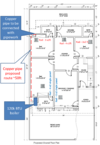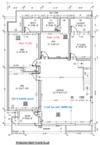- Joined
- 27 Sep 2022
- Messages
- 210
- Reaction score
- 17
- Country

I have a 320 sqft double storey house with 6 bedrooms. The house is serviced by two heat only boilers (non condensing); a 120k btu (35kw) and a 70k btu (20kw). Both Boilers are installed at ground floor (120k at front and 70k at the back). Front boiler serving front downstairs and upstairs rooms and the back one serving ground floor and upstairs rooms at the back. 22mm Copper pipework from boiler with branches going upstairs and terminated to radiators 8mm. The house has larger rooms at the front side and smaller rooms at the back.
I must tell you that this was installed without heat loss calculation so the front boiler is only serving;
Ground Floor= a 252 sqft room; 320 sqft. Lounge with 600x1400mm Type 11 radiators installed in each room. Both rooms maintain temperature very well.
Upper floor 252sq.ft room (Type 22 radiator recently installed) and a 650sqft lounge with fan assisted coil unit installed.
What I am trying to achieve
I am on my learning curve with the system and my heat calculation tells me that the front 35kw boiler would be enough with 12 radiators in total for the whole house including small radiators in bathrooms. To do this I need to extend the pipework from front to back; two copper pipes 22mm for 35ft length.
Questions :
1. From where do I take a connection out from existing 22mm copper pipes; upstairs or downstairs? Would this length require a separate pump to be installed to serve pipework this long?
2. Would the existing heating be compromised (front rooms if I extend the pipework)?
3. Would I be saving any money; running two boilers instead of one. I have gas rated the boiler and bigger boiler consumes 1m3/hr at 70deg C flow. Extending the pipework will increase my gas usage, correct?
Many Thanks in advance.
I must tell you that this was installed without heat loss calculation so the front boiler is only serving;
Ground Floor= a 252 sqft room; 320 sqft. Lounge with 600x1400mm Type 11 radiators installed in each room. Both rooms maintain temperature very well.
Upper floor 252sq.ft room (Type 22 radiator recently installed) and a 650sqft lounge with fan assisted coil unit installed.
What I am trying to achieve
I am on my learning curve with the system and my heat calculation tells me that the front 35kw boiler would be enough with 12 radiators in total for the whole house including small radiators in bathrooms. To do this I need to extend the pipework from front to back; two copper pipes 22mm for 35ft length.
Questions :
1. From where do I take a connection out from existing 22mm copper pipes; upstairs or downstairs? Would this length require a separate pump to be installed to serve pipework this long?
2. Would the existing heating be compromised (front rooms if I extend the pipework)?
3. Would I be saving any money; running two boilers instead of one. I have gas rated the boiler and bigger boiler consumes 1m3/hr at 70deg C flow. Extending the pipework will increase my gas usage, correct?
Many Thanks in advance.


